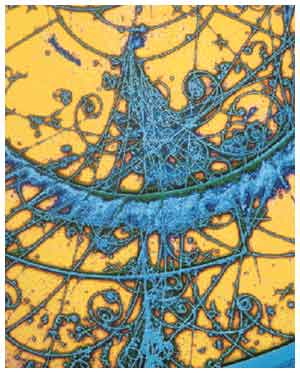 Deep in a tank of liquid hydrogen, a proton struck by a speeding neutrino disintegrates into a spray of subatomic particles in this artist-enhanced image from the European Centre for Nuclear Research (CERN) in Geneva, Switzerland. The reaction may approximate conditions that existed in the early universe. |
explosion created equal amounts of matter and antimatter  , particles with identical masses and spins as their matter counterparts but with opposite charges. But when we look around us today, we see precious little antimatter , particles with identical masses and spins as their matter counterparts but with opposite charges. But when we look around us today, we see precious little antimatter  . That's a good thing, because a blob of antimatter . That's a good thing, because a blob of antimatter  would annihilate you in a burst of gamma rays would annihilate you in a burst of gamma rays  if you touched it. Soon after the Big Bang if you touched it. Soon after the Big Bang  some unknown interaction tipped the scales in favor of matter. The imbalance was tiny: For every billion particles of antimatter some unknown interaction tipped the scales in favor of matter. The imbalance was tiny: For every billion particles of antimatter  , there were a billion and one particles of matter. All of the matterantimatter , there were a billion and one particles of matter. All of the matterantimatter  pairs were annihilated in an orgy of photons, leaving behind a smidgen of matter. Well, not quite. That "smidgen" comprises everything in the cosmos today. We owe our existence to the mysterious interaction that skewed nature toward matter. Physicists are in hot pursuit of this interaction as a possible first glimpse past the standard model. pairs were annihilated in an orgy of photons, leaving behind a smidgen of matter. Well, not quite. That "smidgen" comprises everything in the cosmos today. We owe our existence to the mysterious interaction that skewed nature toward matter. Physicists are in hot pursuit of this interaction as a possible first glimpse past the standard model.
Beyond that prize, the holy grail in particle physics today is the immodestly named "theory of everything  ." Such a theory would unite the forces of nature into a grand description of how all particles interact and why they have the properties they do. Normally, the four fundamental forces act separately from one another and with different strengths. But this is not always true. Physicists have shown that electromagnetism ." Such a theory would unite the forces of nature into a grand description of how all particles interact and why they have the properties they do. Normally, the four fundamental forces act separately from one another and with different strengths. But this is not always true. Physicists have shown that electromagnetism  and the weak force and the weak force  are different manifestations of a single force, called "electroweak are different manifestations of a single force, called "electroweak  ." This force exists only when the energies of particles--which we can think of as their temperatures--get very high. How high? How about a quadrillion degrees, the temperature of the universe less than a billionth of a second after the Big Bang ." This force exists only when the energies of particles--which we can think of as their temperatures--get very high. How high? How about a quadrillion degrees, the temperature of the universe less than a billionth of a second after the Big Bang  . Seeing this one force act as two forces in our everyday world is like seeing water exist as ice, liquid, vapor, or scalding steam, depending on the conditions. We recognize each substance as water, even though superficially they are not anything alike. . Seeing this one force act as two forces in our everyday world is like seeing water exist as ice, liquid, vapor, or scalding steam, depending on the conditions. We recognize each substance as water, even though superficially they are not anything alike.
At even higher energies the other two fundamental forces may also merge. The strong force  would join next but only at the temperatures that raged in the universe when it was just slightly more than a trillion trillion trillionth of a second old. That's way beyond the reach of our particle accelerators. Even so, physicists have developed descriptions of how The strong force would join next but only at the temperatures that raged in the universe when it was just slightly more than a trillion trillion trillionth of a second old. That's way beyond the reach of our particle accelerators. Even so, physicists have developed descriptions of how The strong force  , the weak force , the weak force  , and electromagnetism , and electromagnetism  behave as (continued) behave as (continued) |

